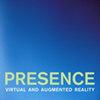The Perception of Distance in Simulated Visual Displays:A Comparison of the Effectiveness and Accuracy of Multiple Depth Cues Across Viewing Distances
IF 0.7
4区 计算机科学
Q4 COMPUTER SCIENCE, CYBERNETICS
引用次数: 97
Abstract
The ability effectively and accurately to simulate distance in virtual and augmented reality systems is a challenge currently facing R&D. To examine this issue, we separately tested each of seven visual depth cues (relative brightness, relative size, relative height, linear perspective, foreshortening, texture gradient, and stereopsis) as well as the condition in which all seven of these cues were present and simultaneously providing distance information in a simulated display. The viewing distances were 1 and 2 m. In developing simulated displays to convey distance and depth there are three questions that arise. First, which cues provide effective depth information (so that only a small change in the depth cue results in a perceived change in depth)? Second, which cues provide accurate depth information (so that the perceived distance of two equidistant objects perceptually matches)? Finally, how does the effectiveness and accuracy of these depth cues change as a function of the viewing distance? Ten college-aged subjects were tested with each depth-cue condition at both viewing distances. They were tested using a method of constant stimuli procedure and a modified Wheat-stone stereoscopic display. The perspective cues (linear perspective, foreshortening, and texture gradient) were found to be more effective than other depth cues, while effectiveness of relative brightness was vastly inferior. Moreover, relative brightness, relative height, and relative size all significantly decreased in effectiveness with an increase in viewing distance. The depth cues did not differ in terms of accuracy at either viewing distance. Finally, some subjects experienced difficulty in rapidly perceiving distance information provided by stereopsis, but no subjects had difficulty in effectively and accurately perceiving distance with the perspective information used in our experiment. A second experiment demonstrated that a previously stereo-anomalous subject could be trained to perceive stereoscopic depth in a binocular display. We conclude that the use of perspective cues in simulated displays may be more important than the other depth cues tested because these cues are the most effective and accurate cues at both viewing distances, can be easily perceived by all subjects, and can be readily incorporated into simpler, less complex displays (e.g., biocular HMDs) or more complex ones (e.g., binocular or see-through HMDs).模拟视觉显示中的距离感知:跨观看距离的多个深度线索的有效性和准确性比较
在虚拟现实和增强现实系统中,如何有效、准确地模拟距离是当前研发面临的一个挑战。为了研究这个问题,我们分别测试了七个视觉深度线索(相对亮度、相对大小、相对高度、线性视角、缩短、纹理梯度和立体视觉),以及所有这些线索同时存在并在模拟显示中提供距离信息的条件。观察距离分别为1 m和2 m。在开发模拟显示以显示距离和深度时,会出现三个问题。首先,哪些线索提供了有效的深度信息(只有深度线索的微小变化才会导致深度的感知变化)?第二,哪些线索提供了准确的深度信息(从而使两个等距物体的感知距离在感知上匹配)?最后,这些深度线索的有效性和准确性如何随着观看距离的变化而变化?10名大学生在两种观看距离下分别接受了深度提示条件的测试。他们使用恒定刺激程序和改进的Wheat-stone立体显示器进行测试。透视提示(线性透视、透视和纹理渐变)比其他深度提示更有效,而相对亮度提示的效果则差得多。此外,相对亮度、相对高度和相对尺寸的有效性都随着观看距离的增加而显著降低。深度线索在两种观看距离上的准确性没有差异。最后,部分被试在快速感知立体视觉提供的距离信息时存在困难,但在有效、准确地感知我们实验中使用的透视信息时,没有被试存在困难。第二个实验表明,先前立体异常的受试者可以通过训练来感知双目显示器中的立体深度。我们得出的结论是,在模拟显示中使用透视提示可能比其他深度提示更重要,因为这些提示在两种观看距离下都是最有效和准确的提示,可以被所有受试者轻松感知,并且可以很容易地合并到更简单,不太复杂的显示(例如,生物眼头显)或更复杂的显示(例如,双目或透明头显)中。
本文章由计算机程序翻译,如有差异,请以英文原文为准。
求助全文
约1分钟内获得全文
求助全文
来源期刊
CiteScore
2.20
自引率
0.00%
发文量
8
审稿时长
>12 weeks

 求助内容:
求助内容: 应助结果提醒方式:
应助结果提醒方式:


